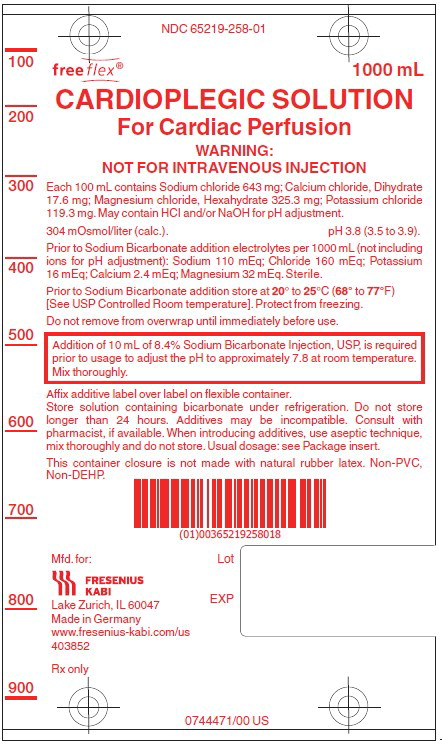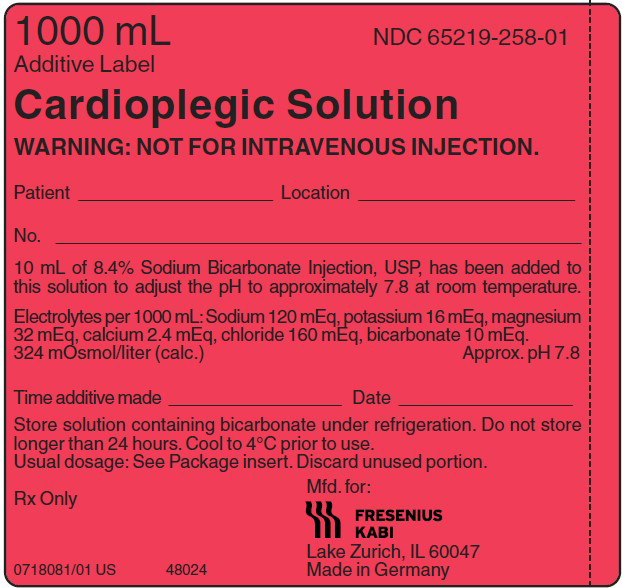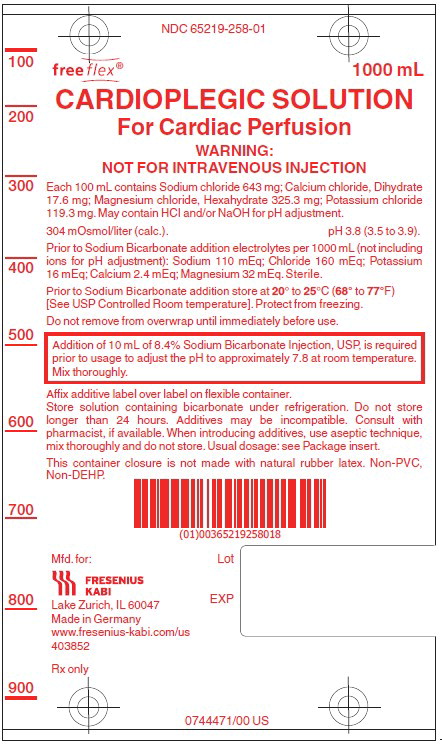Label: CARDIOPLEGIC SOLUTION- potassium chloride, sodium chloride, calcium chloride, and magnesium chloride injection, solution
- NDC Code(s): 65219-258-01, 65219-258-10
- Packager: Fresenius Kabi, USA, LLC
- Category: HUMAN PRESCRIPTION DRUG LABEL
- DEA Schedule: None
- Marketing Status: Abbreviated New Drug Application
Drug Label Information
Updated May 27, 2022
If you are a consumer or patient please visit this version.
- Download DRUG LABEL INFO: PDF XML
- Official Label (Printer Friendly)
- SPL UNCLASSIFIED SECTION
-
DESCRIPTION
Cardioplegic Solution is a sterile, nonpyrogenic, essentially isotonic, formulation of electrolytes in water for injection. It is a "core solution" intended for use only after addition of sodium bicarbonate to adjust pH prior to administration. After buffering with sodium bicarbonate it is suitable for cardiac instillation (usually with hypothermia) to induce arrest during open heart surgery. Other agents may be added to the solution prior to instillation (See INSTRUCTIONS FOR USE).
Each 100 mL of solution contains calcium chloride, dihydrate 17.6 mg, magnesium chloride, hexahydrate 325.3 mg, potassium chloride 119.3 mg and sodium chloride 643 mg in water for injection. May contain HCl or NaOH for pH adjustment. Electrolyte content per liter (not including ions for pH adjustment): Calcium (Ca++) 2.4 mEq; magnesium (Mg++) 32 mEq; potassium (K+) 16 mEq; sodium (Na+) 110 mEq; chloride (Cl‾) 160 mEq. Osmolar concentration, 304 mOsmol/liter (calc.); pH 3.8 (3.5 to 3.9) prior to sodium bicarbonate addition.
It is required that 10 mL (840 mg) of 8.4% Sodium Bicarbonate Injection, USP (10 mEq each of sodium and bicarbonate) be added aseptically and thoroughly mixed with each 1000 mL of cardioplegic solution to adjust pH. Use 10 mL of 8.4% Sodium Bicarbonate Injection, USP, to achieve the approximate pH of 7.8 when measured at room temperature. Use of any other Sodium Bicarbonate Injection may not achieve this pH due to the varying pH's of Sodium Bicarbonate Injections. Due to its inherent instability with other components, sodium bicarbonate must be added just prior to administration. After this addition, the solution must be stored under refrigeration and be used within 24 hours.
The buffered admixture contains the following electrolytes (per liter): Ca++ 2.4 mEq, Mg++ 32 mEq, K+ 16 mEq, Na+ 120 mEq, Cl‾ 160 mEq and bicarbonate (HCO3‾) 10 mEq; osmolar concentration, 324 mOsmol/liter (calc.); pH 7.8 (approx.). If other agents are added, these values may be altered.
The solution contains no bacteriostat, or antimicrobial agent and is intended only for use (after adjusting pH with sodium bicarbonate) in a single operative procedure. When smaller amounts are required, the unused portion should be discarded.
Cardioplegic Solution with added sodium bicarbonate used as a coronary artery infusate induces cardiac arrest, combats ischemic ionic disturbances, buffers ischemic acidosis and protects energy sources for functional recovery after ischemia.
Calcium Chloride, USP is chemically designated calcium chloride, dihydrate (CaCl2 • 2 H2O), white fragments or granules freely soluble in water.
Magnesium Chloride, USP is chemically designated magnesium chloride, hexahydrate (MgCl2 • 6 H2O), deliquescent flakes or crystals very soluble in water.
Potassium Chloride, USP is chemically designated KCl, a white granular powder freely soluble in water.
Sodium Chloride, USP is chemically designated NaCl, a white crystalline powder freely soluble in water.
Water for Injection, USP is chemically designated H2O.
The flexible plastic container is fabricated from a specially formulated non-plasticized, film containing polypropylene and thermoplastic elastomers (freeflex® bag). Water can permeate from inside the container into the overwrap but not in amounts sufficient to affect the solution significantly. Solutions in contact with the plastic container may leach out certain chemical components from the plastic in very small amounts; however, biological testing was supportive of the safety of the plastic container materials. Exposure to temperatures above 25°C/77°F during transport and storage will lead to minor losses in moisture content. Higher temperatures lead to greater losses. It is unlikely that these minor losses will lead to clinically significant changes within the expiration period.
-
CLINICAL PHARMACOLOGY
Cardioplegic Solution with added sodium bicarbonate when cooled and instilled into the coronary artery vasculature, causes prompt arrest of cardiac electromechanical activity, combats intracellular ion losses and buffers ischemic acidosis. When used with hypothermia and ischemia, the action may be characterized as cold ischemic potassium-induced cardioplegia. This is conducive to providing the surgeon with a quiet, relaxed heart and bloodless field of operation.
Calcium (Ca++) ion in low concentration is included in the solution to maintain integrity of cell membrane to ensure that there is no likelihood of calcium paradox during reperfusion.
Magnesium (Mg++) ion may help stabilize the myocardial membrane by inhibiting a myosin phosphorylase, which protects adenosine triphosphate (ATP) reserves for postischemic activity. The protective effects of magnesium and potassium have been shown to be additive.
Potassium (K+) ion concentration is responsible for prompt cessation of mechanical myocardial contractile activity. The immediacy of the arrest thus preserves energy supplies for postischemic contractile activity in diastole.
The chloride (Cl‾) and sodium (Na+) ions have no specific role in the production of cardiac arrest. Sodium is essential to maintain ionic integrity of myocardial tissue. The chloride ions are present to maintain the electroneutrality of the solution.
Added bicarbonate (HCO3‾) anion is included as a buffer to render the solution slightly alkaline and compensate for the metabolic acidosis that accompanies ischemia.
Extemporaneous alternative buffering to the described formulation of this solution is not recommended.
- INDICATIONS AND USAGE
- CONTRAINDICATIONS
-
WARNINGS
This solution should be used only by those trained to perform open heart surgery. This solution is intended only for use during cardiopulmonary bypass when the coronary circulation is isolated from the systemic circulation (See INDICATIONS AND USAGE).
Do not instill the solution into the coronary vasculature unless sodium bicarbonate has been added. If large volumes of cardioplegic solution are infused and allowed to return to the heart lung machine without any venting from the right heart, then plasma magnesium and potassium levels may rise. Development of severe hypotension and metabolic acidosis while on bypass has been reported when large volumes (8 to 10 liters) of solution are instilled and allowed to enter the pump and then the systemic circulation. Right heart venting is therefore recommended. The buffered solution with added sodium bicarbonate should be cooled to 4°C prior to administration and used within 24 hours of mixing.
-
PRECAUTIONS
Myocardial temperature should be monitored during surgery to maintain hypothermia.
Continuous electrocardiogram monitoring is essential to detect changes in myocardial activity during the procedure. Appropriate equipment to defibrillate the heart following cardioplegia should be readily available.
Inotropic support drugs should be available during postoperative recovery.
Do not administer unless solution is clear and container is undamaged. Discard unused portion.
Drug Interactions
Additives may be incompatible. Consult with pharmacist, if available. When introducing additives, use aseptic technique, mix thoroughly and do not store (See INSTRUCTIONS FOR USE).
Pregnancy: Animal reproduction studies have not been conducted with Cardioplegic Solution. It is also not known whether this solution can cause fetal harm when administered to a pregnant woman or can affect reproduction capacity. Cardioplegic Solution should be given to a pregnant woman only if clearly needed.
Pediatric Use
Safety and effectiveness in pediatric patients have not been established. Because of differences in structure, function, and metabolism, clinical myocardial protection strategies and Cardioplegia solutions that are effective in adult hearts may be less effective in the immature heart.
Geriatric Use
Clinical studies of Cardioplegic Solution did not include sufficient numbers of subjects aged 65 and over to determine whether they responded differently from younger subjects. Other reported clinical experience has not identified differences in responses between older and younger patients.
In general, dose selection for an elderly patient should be cautious, usually starting at the low end of the dosage range reflecting the greater frequency of decreased hepatic, renal, or cardiac function, and of concomitant disease.
This product is unique in that there is no hepatic or renal excretion and specific adjustments for dosing in the elderly are not known.
-
ADVERSE REACTIONS
Intraoperative and perioperative potential hazards of open heart surgery include myocardial infarction, electrocardiographic abnormalities, and arrhythmias, including ventricular fibrillation. Spontaneous recovery after cardioplegic cardiac arrest may be delayed or absent when circulation is restored. Defibrillation by electric shock may be required to restore normal cardiac function.
To report SUSPECTED ADVERSE REACTIONS, contact Fresenius Kabi USA, LLC at 1-800-551-7176 or FDA at 1-800-FDA-1088 or www.fda.gov/medwatch.
-
OVERDOSAGE
Overzealous instillation of the solution may result in unnecessary dilatation of the myocardial vasculature and leakage into the perivascular myocardium, possibly causing tissue edema (See WARNINGS, PRECAUTIONS, and ADVERSE REACTIONS).
-
DOSAGE AND ADMINISTRATION
The following information is suggested as a guide and is subject to variation according to the preference and experience of the surgeon.
It is required that 10 mL (840 mg) of 8.4% Sodium Bicarbonate Injection, USP (10 mEq each of sodium and bicarbonate) be added aseptically and thoroughly mixed with each 1000 mL of cardioplegic solution to adjust pH. Use 10 mL of 8.4% Sodium Bicarbonate Injection, USP, to achieve the approximate pH of 7.8 when measured at room temperature. Use of any other Sodium Bicarbonate Injection may not achieve this pH due to the varying pH's of Sodium Bicarbonate Injections. Due to its inherent instability with other components, sodium bicarbonate must be added just prior to administration. After this addition, the solution must be used within 24 hours. The solution should be cooled to 4°C prior to use.
Following institution of cardiopulmonary bypass at perfusate temperatures of 28° to 30°C, and after cross-clamping of the ascending aorta, the buffered solution is administered by rapid infusion into the aortic root. The initial rate of infusion may be 300 mL/m2/minute (about 540 mL/min in a 5'8", 70 kg adult with 1.8 square meters of surface area) given for a period of two to four minutes. Concurrent external cooling (regional hypothermia of the pericardium) may be accomplished by instilling a refrigerated (4°C) physiologic solution such as Normosol®-R (balanced electrolyte replacement solution) or Ringer's Injection, USP into the chest cavity.
Should myocardial electromechanical activity persist or recur, the solution may be reinfused at a rate of 300 mL/m2/min for a period of two minutes. Reinfusion of the solution may be repeated every 20 to 30 minutes or sooner if myocardial temperature rises above 15° to 20°C or returning cardiac activity is observed. The regional hypothermia solution around the heart also may be replenished continuously or periodically in order to maintain adequate hypothermia. Suction may be used to remove warmed infusates. An implanted thermistor probe may be used to monitor myocardial temperature.
The volumes of solution instilled into the aortic root may vary depending on the duration or type of open heart surgical procedure.
Parenteral drug products should be inspected visually for particulate matter and discoloration prior to administration, whenever solution and container permit (See PRECAUTIONS).
-
INSTRUCTIONS FOR USE
Flexible Plastic Container (freeflex® bag)
Do not remove solution container from its overwrap until immediately before use.
The intact port cap provides visual tamper evidence. Do not use if port cap is prematurely removed. Maintain strict aseptic technique during handling.
To Open
- Always inspect the solution container before and after removal from the overwrap.
- Place the solution container on a clean, flat surface. Remove the solution container from the overwrap.
- Check the solution container for leaks by squeezing firmly. If leaks are found, discard.
To add 10 mL of 8.4% Sodium Bicarbonate Injection, USP, and if other supplemental medication is desired, follow directions below before preparing for administration.
To Add Medication
- Identify WHITE Additive Port with arrow pointing toward solution container.
- Immediately before injecting additives, break off WHITE Additive Port Cap with the arrow pointing toward solution container.
- Hold base of WHITE Additive Port.
- Using aseptic technique, insert needle (18 to 23 gauge) through the center of WHITE Additive Port's septum and inject additives.
- Mix solution container contents thoroughly.
Preparation for Administration
(Use aseptic technique)
- Close the flow control clamp of the administration set.
- Immediately before inserting the administration set, break off BLUE Infusion Port Cap with the arrow pointing away from solution container.
- Hold the base of BLUE Infusion Port, twist and push the spike until the spike is fully inserted. NOTE: See full directions accompanying administration set.
- The BLUE infusion port contains a self‐sealing septum that helps prevent leakage after removing the spike. The infusion port is not intended to be spiked more than once.
- Suspend solution container from hanger hole.
- Squeeze and release drip chamber to establish proper fluid level in chamber.
- Attach aortic infusion device to set.
- Open flow control clamp to expel air from set and aortic infusion device. Close clamp.
- Position aortic infusion device to introduce solution into aortic root.
- Regulate rate of administration with flow control clamp.
- For Single use Only. Discard unused portion.
-
HOW SUPPLIED
Cardioplegic Solution is supplied (without sodium bicarbonate) in a single-dose 1000 mL freeflex® plastic container as follows:
Product Code Unit of Use Unit of Sale 258810 NDC 65219-258-01
One 1000 mL freeflex® bagNDC 65219-258-10
Package of 10 freeflex® bagsWARNING: Do not use flexible container in series connections.
Store at 20° to 25°C (68° to 77°F). [See USP Controlled Room Temperature.] Protect from freezing.
The container closure is not made with natural rubber latex. Non-PVC, Non-DEHP, Sterile.
Manufactured for:
Lake Zurich, Illinois 60047
Made in Germany
451744
www.fresenius-kabi.com/usIssued: April 2022
- PRINCIPAL DISPLAY PANEL
- PACKAGE LABEL - PRINCIPAL DISPLAY – Cardioplegic Solution Additive Label
-
INGREDIENTS AND APPEARANCE
CARDIOPLEGIC SOLUTION
potassium chloride, sodium chloride, calcium chloride, and magnesium chloride injection, solutionProduct Information Product Type HUMAN PRESCRIPTION DRUG Item Code (Source) NDC:65219-258 Route of Administration INTRA-ARTERIAL Active Ingredient/Active Moiety Ingredient Name Basis of Strength Strength POTASSIUM CHLORIDE (UNII: 660YQ98I10) (POTASSIUM CATION - UNII:295O53K152, CHLORIDE ION - UNII:Q32ZN48698) POTASSIUM CHLORIDE 119.3 mg in 100 mL SODIUM CHLORIDE (UNII: 451W47IQ8X) (SODIUM CATION - UNII:LYR4M0NH37, CHLORIDE ION - UNII:Q32ZN48698) SODIUM CHLORIDE 643 mg in 100 mL CALCIUM CHLORIDE (UNII: M4I0D6VV5M) (CALCIUM CATION - UNII:2M83C4R6ZB, CHLORIDE ION - UNII:Q32ZN48698) CALCIUM CHLORIDE 17.6 mg in 100 mL MAGNESIUM CHLORIDE (UNII: 02F3473H9O) (MAGNESIUM CATION - UNII:T6V3LHY838, CHLORIDE ION - UNII:Q32ZN48698) MAGNESIUM CHLORIDE 325.3 mg in 100 mL Inactive Ingredients Ingredient Name Strength HYDROCHLORIC ACID (UNII: QTT17582CB) SODIUM HYDROXIDE (UNII: 55X04QC32I) WATER (UNII: 059QF0KO0R) Packaging # Item Code Package Description Marketing Start Date Marketing End Date 1 NDC:65219-258-10 10 in 1 CASE 06/06/2022 1 1 in 1 POUCH 1 NDC:65219-258-01 1000 mL in 1 BAG; Type 2: Prefilled Drug Delivery Device/System (syringe, patch, etc.) Marketing Information Marketing Category Application Number or Monograph Citation Marketing Start Date Marketing End Date ANDA ANDA214623 06/06/2022 Labeler - Fresenius Kabi, USA, LLC (013547657) Establishment Name Address ID/FEI Business Operations Fresenius Kabi Deutschland GmbH 506719546 ANALYSIS(65219-258) , MANUFACTURE(65219-258)








